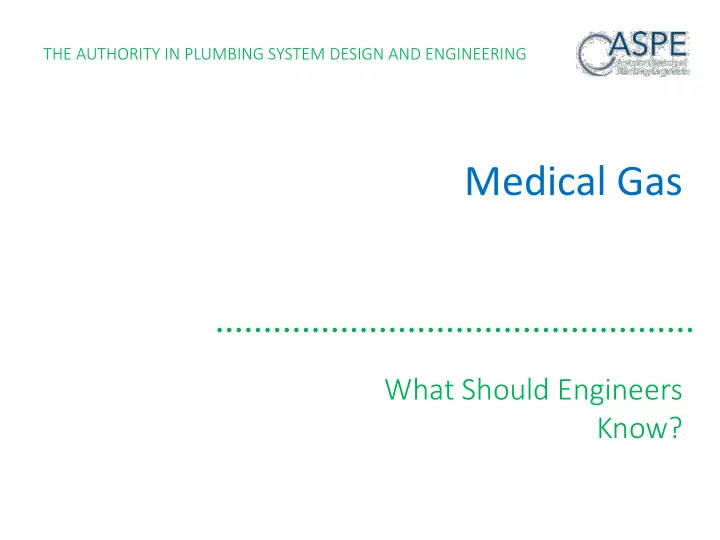

THE AUTHORITY IN PLUMBING SYSTEM DESIGN AND ENGINEERING Medical Gas What Should Engineers Know?
THE AUTHORITY IN PLUMBING SYSTEM DESIGN AND ENGINEERING Course Description In this course we will discuss a variety of items that every • engineer should be aware of which will lead to the medical gas system being installed in such a manner that promotes patient well-being and safety. Utilizing industry “lessons learned” and code sections hopefully we can help eliminate some of the most common (and costly) mistakes. Additionally we will go over some of the differences between the upcoming 2018 edition of NFPA 99 compared to previous editions.
Learning Objectives 1. Why are medical gases important? 2. Pre-design (codes, standards, and AHJ’s) 3. Design coordination (common items) 4. Construction administration - and beyond 5. NFPA 99 2018 Update
Why Is This Important? When not properly installed, medical gases can be dangerous. Austin Stone •
Pre- Design: Codes, Standards, and… NFPA 99 2012: Category 1 - “major injury or death” - ICU • Category 2 - “minor injury” - Outpatient • Category 3 - “discomfort” – Dental (?) • Category 4 – N/A •
Pre- Design: Codes, Standards, and…
Pre- Design: Codes, Standards, and… Anesthesia
Pre- Design: Codes, Standards, and…
Pre- Design: Codes, Standards, and…
Pre- Design: Codes, Standards, and…
Pre- Design: Codes, Standards, and… 5.1.3.5.2 Permitted Location for Medical Gases 1) Direct respiration by patients 2) Clinical application of the gas to a patient , such as the use of an insufflator 3) Medical device applications directly related to respiration [by patient ] 4) Power for medical devices used directly on patients 5) Calibration of medical devices intended for (1) through (4)
Pre-Design: Who is the AHJ for Medical Gas Systems?
Pre-Design: Who is the AHJ for Medical Gas Systems? • Medical gas inspector and verifier Third party hired by owner • Certified (i.e. Inspector ASSE 6020, Verifier • ASSE 6030) Same person? • Worth identifying and getting involved • early!
Design Coordination: Source Equipment Vs. Vs.
Design Coordination: Source Equipment
Design Coordination: EOSC Coordination Emergency Oxygen Supply connection • 11.7.3.5.1.1 – Protect oxygen from coming in contact with asphalt due to spark/static concerns. • 20' w x 20' long Concrete pad for EOSC • For EOSC - 18' long trailer, 500 gal • Standard Oxygen tanker is 65' long
Design Coordination: Why are all these locations important?
Design Coordination: ZVB • Depth
Design Coordination: ZVB • Width
Design Coordination: ZVB 5.1.4.8 Zone Valves. All station outlets/inlets shall be supplied through a zone valve as follows: 1) The zone valve shall be placed such that a wall intervenes between the valve and outlets/inlets that it controls 2) The zone valve shall serve only outlets/inlets located in the same story 3) The zone valve shall not be located in a room with station outlets/inlets that it controls.
Design Coordination: ZVB
Design Coordination: ZVB 5.1.4.8.4 zone valve boxes shall be installed where they are visible and accessible at all times.
Construction - and Beyond System checks (and back checks) Required when a system is breached: pipeline intrusion or • component replacement. System meets NFPA 99 Standards • Proper equipment and material were used • Work was performed % pretested by credentialed installers • Systems are functioning properly • Gas purity/particulates are safe for patient use. • Documentation for facility record. •
Construction - and Beyond: Installer Preconstruction Meeting Certification Review • Material Review • ASSE 6010 System Clearing • Pressure Test • Cross Connection Test • Initial Piping Purge Test • Repair Leaks and Defects • Repair Medical Gas Systems • Provide Report to Engineer •
Construction - and Beyond: Inspector ASSE 6020 Inspector’s Log • Test and Inspection Report • Document List • Confirm compliance with NFPA 99 • Visual inspections • Final System Verification Report • Report Data •
Construction - and Beyond: Verifier ASSE 6030 Prepare Test Equipment • Medical Gas Concentration Test • Standing Pressure and • Medical Air Purity Test for • Vacuum Tests Compressor Systems Cross-Connection Test • Labeling of System Components • Shut-Off Valve Test • Medical Gas Supply Source Tests • Master, Area, and Local • Medical Air Compressor System • Alarm Test Tests Piping Purge Test • Medical/Surgical Vacuum System • Piping particulate Test • Tests Piping Purity Test • Bulk Medical Gas Supply System • Final Tie-In Test • Tests Operational Pressure Test • Odor Test (2015) •
NFPA 99 2018 Updates: Items of Note A new Chapter 15, on dental gas and vacuum piping systems within • a healthcare facility, has been added to the code. All information pertaining to dental facilities has been removed from • the text of Category 3. Permitted Locations: added simulation areas. • Auxiliary Source Connection now required. • Corrugated Medical Gas Tubing (CMT) is now allowed. • HEPA filter now required on vacuum inlet of the vacuum system inlet. •
Summary Pre-design (codes, standards, and AHJ’s) • Design coordination (common items) • Construction - and beyond • NFPA 99 2018 Update • Why is this important? •
Questions? CHRISTOPH LOHR PE, CPD, LEED AP BD+C, ASSE 6020 Technical Leader | Plumbing Engineer HENDERSON ENGINEERS 5343 N. 16th Street, Suite 460 | Phoenix, AZ 85016 TEL (602) 336-5240 CELL (248) 736-4940 christoph.lohr@hendersonengineers.com HENDERSONENGINEERS.COM LICENSED IN AZ, NV “CREATING ENVIRONMENTS WHERE PEOPLE CAN REACH THEIR FULL POTENTIAL.”
Recommend
More recommend